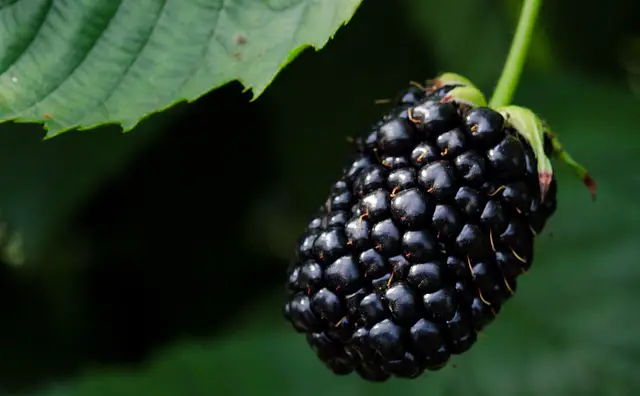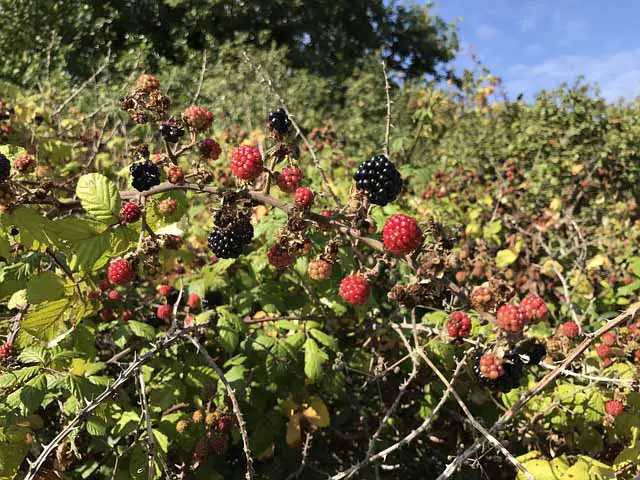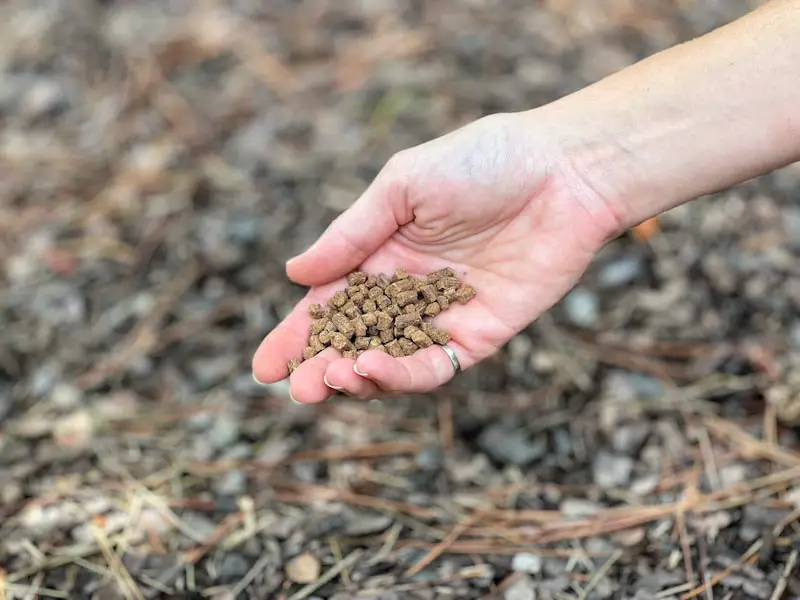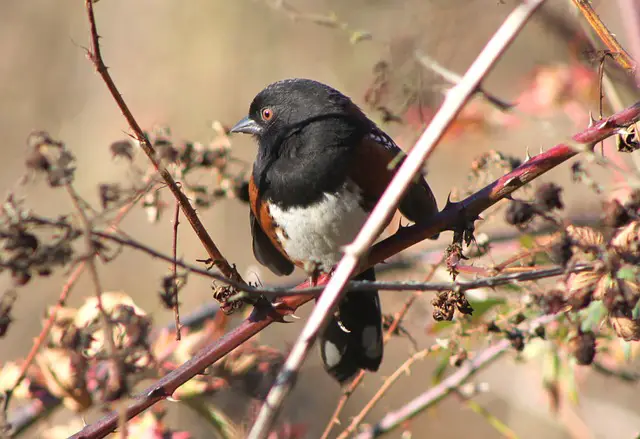
We may receive commissions from purchases made through links in this post, at no additional cost to you.
I was so excited to plant my own blackberry bushes. I couldn’t wait to harvest pint after pint of huge, juicy berries to use in the kitchen (if they even made it that far). Imagine my disappointment when, after the first growing season, all I got was some small, tart, firm berries that even the birds wouldn’t touch.
Since then, I have made many improvements to my blackberry-growing game. Luckily, there are some simple ways to ensure that you don’t make the same mistakes I did, and to help your blackberries grow as big and juicy as possible.
Blackberries will be larger and juicier when provided with the right growing conditions, pruning practices, fertilizing, watering, and protection from pests and diseases. Certain cultivars are known for producing very large berries, including ‘Kiowa’, ‘Navaho’, and ‘Triple Crown’.
Like so many things in life, plants will respond positively when given the proper care and attention. With blackberries, that means rewarding you with big, succulent fruit that is far superior to anything you could buy in a store. Read on to see how to grow the biggest blackberries on the block.
1. Choose the right variety.
If your goal is to have giant blackberries the size of your thumb (give or take…I have really long fingers), then choosing a large-fruiting variety is a must. Some blackberry cultivars will only produce fruit that stays small to medium-sized, even with ideal care. If your growing zone and conditions allow it, plant one of the large berry varieties below.
Learn more: The Best-Tasting Thornless Blackberries (9 Top Picks)

Blackberry Varieties for Large Fruit
‘Triple Crown’
- Thornless
- Ripens in July
- Semi-erect habit
- Zones 5-9
- Vigorous grower, great flavor
‘Columbia Giant’
- Thornless
- Ripens in July
- Trailing habit
- Zones 5-8
- Very large, conical fruit (2 inches or more)
‘Kiowa’
- Thorny
- Ripens in June
- Erect habit
- Zones 5-8
- Long harvest season, probably the largest variety (up to 3 inches)
‘Navaho’
- Thornless
- Ripens in June
- Semi-erect habit
- Zones 5-9
- Tolerates clay soil, very sweet medium-large berries
‘Black Satin’
- Thornless
- Ripens in July
- Semi-erect habit
- Zones 5-8
- Heat tolerant plant, large juicy berries
I wrote an article about different blackberry varieties, whether you’re looking for cold hardiness, disease resistance, size, flavor, or fruiting time: Blackberry Variety Breakdown: Biggest, Sweetest, and More.
2. Provide the right conditions.
Selecting a good blackberry planting site will make your job as a gardener so much easier. A plant that’s grown in an ideal place will be healthier, tougher, and provide better (and bigger!) fruit. Blackberries are relatively low-maintenance once established, but they will definitely perform better in the right conditions.
Like most fruits, blackberries need full sun to produce fruit. Aim for at least 6-8 hours of sun per day. In areas with very hot summers, some afternoon shading will protect the plants from heat stress.

Soil should be fertile, but well-draining. Blackberries grow best in sandy loam with a pH range of 4.5 to 7.5 (slightly acidic). They do not like to sit in wet soil, so amend heavy clay with plenty of compost to improve drainage. Blackberry bushes have shallow roots, so keep the area clear of weeds to avoid nutrient competition.
Keep mulch around your blackberry plants to cool the roots, retain moisture, and deter weeds. Blackberries only need moderate water – about 1 inch per week from rain or other irrigation. Once the plants are established they can tolerate brief periods of drought, although they should be watered regularly during the fruiting season.
Blackberries need some cold to go dormant each year, but they don’t like areas that regularly drop below 0°F. Winter wet may be a problem in some northern zones that get a lot of snow. A really wet spring, where the soil stays constantly soggy, could kill the plant. Blackberries do like humid climates and can struggle to produce a good harvest in areas with hot, dry winds.
Not sure if you planted your blackberries in the right spot? Learn about how to move them here: Transplanting a Mature Blackberry Bush: Tips to Do It Right.
3. Prune to encourage larger fruit and bigger harvests.
If you let your blackberries grow the way they want, they’ll become an unruly, wild thicket. The first year I planted blackberry bushes I left them to their own devices – and they grew canes about 10 feet tall and had small, disappointing berries. But since then I have taken care to prune them each year – and big, juicy berries are my reward.
When you prune blackberry bushes and select only a few canes to keep, the plant can put all of its energy toward producing better fruit. The more growth there is, the harder the plant has to work to support that growth – which means the blackberries will be smaller in size and number.

Blackberry pruning doesn’t have to be complicated. In a nutshell: remove any canes that had fruit the previous year in the late winter or early spring. These canes are done and won’t grow any more berries.
Of the canes that are left, choose 4 or 5 strong ones to keep. Cut these down to about 3 to 4 feet to encourage branching, which is where this year’s fruit will grow. If you like, you can train your blackberries onto a trellis or against a fence or wall for support.
Once the berries have been harvested, go ahead and cut the fruiting canes back to the ground. The remaining canes can be tipped and cut down to a few feet to encourage branches that will fruit next year. Continue this process each season to maximize the size of your fruit (and the size of your harvest!).
Learn more: The Ultimate Guide to Pruning Blackberries (with Photos)
4. Fertilize in spring.
Too-small berries may indicate that your blackberry bushes need more nutrients, so try some strategic fertilizing. If you have chosen a good planting site with fertile, sandy soil, they shouldn’t need too much additional food. But a yearly application of fertilizer at the beginning of the growing season may help the plant produce larger fruit.
Learn more: Blackberry Fertilizing: What to Use to Grow the Best Berries
At the beginning of spring, when you notice your blackberry bushes starting to grow, fertilize with a complete, fairly balanced, all-purpose fertilizer. I use a slow-release, organic granular fertilizer like this one, although there are many other good options out there.

Many growers also recommend using Epsom salt with blackberries. Epsom salt is magnesium sulfate, two minerals that are very beneficial to many plants. It can be dissolved in water and sprayed as a foliar spray (about 2 tablespoons per gallon of water), or sprinkled around the base of the plant and watered in. Epsom salts can help the plant absorb more phosphorus and nitrogen, two elements that are key for growing bigger and better berries.
Mulch around blackberry bushes in the fall with well-rotted manure or compost. Avoid applying other fertilizers after fruiting, since the plant needs to prepare for dormancy.
5. Watch out for redberry mites.
If you notice that your blackberries are small, hard, and have red spots, then there’s a good chance you’re dealing with a redberry mite infestation. These are tiny insects that feed on the ripening berries and inject the drupelets with a toxin that turns the fruit red. The mites survive over the winter and will come back again once growth starts in spring.
Learn more reasons for reddening blackberries here: Blackberries Turning Red? Here’s What’s Happening.
You might notice red spots on the blackberries, or that the whole berry has turned red and never turns black. Some fruit infected by redberry mites will stay small and greenish. An infected berry will never ripen or develop any further.
The best way to treat redberry mites is to prevent them in the first place. Strong, well-cared-for plants will more easily resist pests such as these. If your bush does get infected, prune and discard damaged clusters of fruit right away.
To prevent the mites, apply a horticultural oil when you first notice green fruits starting to grow, and then again every 2-3 weeks for a total of 4 applications. Be sure to spray all of the leaves and growth completely.
If that isn’t enough to prevent or control the infestation, you can apply lime sulfer to the plants. Horticultural oil is gentler and will have less impact on the size of the crop, but lime sulfer may be more effective on redberry mites (wait at least a month after using horticultural oil). Follow package instructions and apply up to 2 weeks before the fruit harvest.
6. Protect from the birds.

You’ve done all of this work to ensure the biggest, juiciest blackberries possible. The last thing you want to do is share them with the wildlife. Birds would love nothing more than to swoop in and much on the blackberries just a day or two before you were about to pick them (I speak from experience…).
Drape blackberry bushes with lightweight garden netting once the fruit is starting to turn black. This should be enough to deter the birds from ripening fruit. You can drape the netting right over the plants, or attach the netting to tall gardening stakes to cover the entire bush.
You’ll know your giant berries are ready for picking when they pull off the bush with little resistance. Unfortunately, birds seem to have a taste for slightly underripe berries and will often snatch the fruits just when they turn dark. For the best blackberry flavor, wait a few days after you notice a berry turning black. Blackberries don’t keep ripening once picked, so aim to harvest right at peak flavor.

